The Turkish Invasion of Cyprus and the Greek Civil War: Analysis
VerifiedAdded on 2021/09/17
|10
|2431
|117
Essay
AI Summary
This essay provides a detailed analysis of two significant conflicts: the Turkish invasion of Cyprus and the Greek Civil War. The first part examines the impact of the 1974 Turkish invasion on both Greek and Turkish Cypriot communities, including displacement, human rights violations, and the destruction of cultural heritage. It discusses the role of Turkey and the Republic of Cyprus in contributing to the sufferings of the communities. The second part explores the role of foreign intervention in the Greek Civil War (1946-1949), specifically focusing on the influence of the United States, United Kingdom, Bulgaria, and other communist countries. The essay considers the Cold War context, the proxy war dynamics, and the motivations of external parties in shaping the outcome of the conflict, which led to a democratic or communist control in the country.
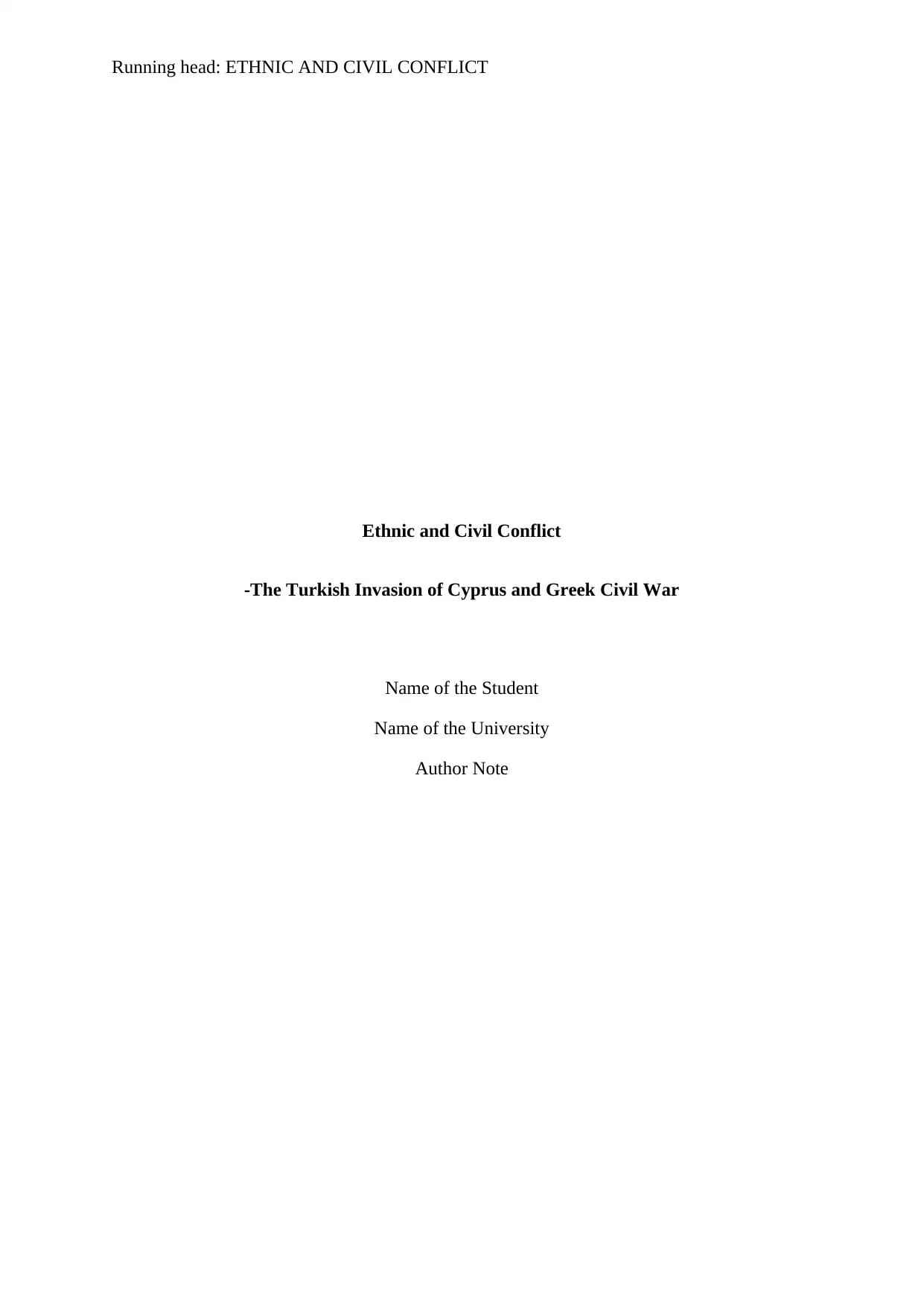
Running head: ETHNIC AND CIVIL CONFLICT
Ethnic and Civil Conflict
-The Turkish Invasion of Cyprus and Greek Civil War
Name of the Student
Name of the University
Author Note
Ethnic and Civil Conflict
-The Turkish Invasion of Cyprus and Greek Civil War
Name of the Student
Name of the University
Author Note
Paraphrase This Document
Need a fresh take? Get an instant paraphrase of this document with our AI Paraphraser
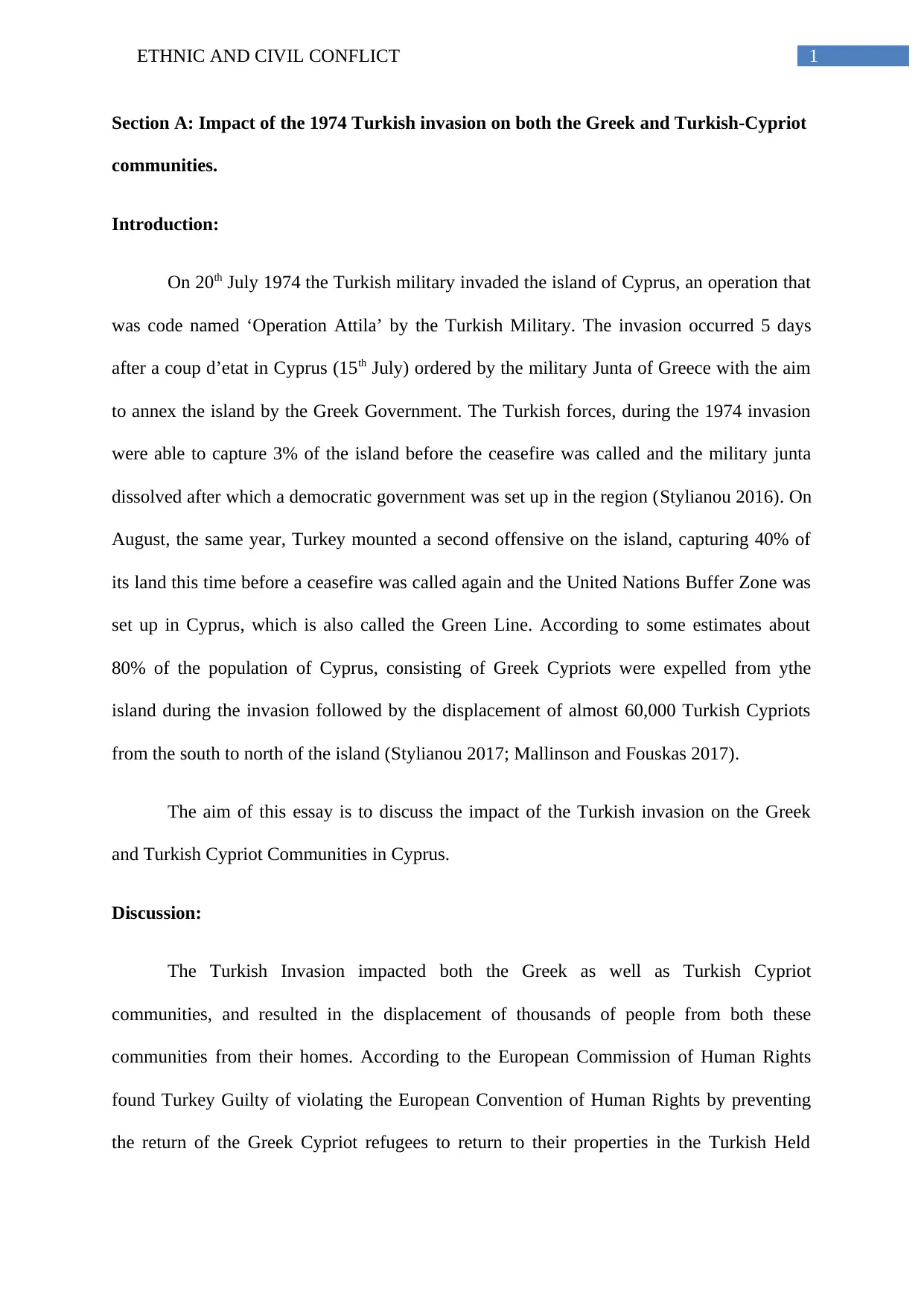
1ETHNIC AND CIVIL CONFLICT
Section A: Impact of the 1974 Turkish invasion on both the Greek and Turkish-Cypriot
communities.
Introduction:
On 20th July 1974 the Turkish military invaded the island of Cyprus, an operation that
was code named ‘Operation Attila’ by the Turkish Military. The invasion occurred 5 days
after a coup d’etat in Cyprus (15th July) ordered by the military Junta of Greece with the aim
to annex the island by the Greek Government. The Turkish forces, during the 1974 invasion
were able to capture 3% of the island before the ceasefire was called and the military junta
dissolved after which a democratic government was set up in the region (Stylianou 2016). On
August, the same year, Turkey mounted a second offensive on the island, capturing 40% of
its land this time before a ceasefire was called again and the United Nations Buffer Zone was
set up in Cyprus, which is also called the Green Line. According to some estimates about
80% of the population of Cyprus, consisting of Greek Cypriots were expelled from ythe
island during the invasion followed by the displacement of almost 60,000 Turkish Cypriots
from the south to north of the island (Stylianou 2017; Mallinson and Fouskas 2017).
The aim of this essay is to discuss the impact of the Turkish invasion on the Greek
and Turkish Cypriot Communities in Cyprus.
Discussion:
The Turkish Invasion impacted both the Greek as well as Turkish Cypriot
communities, and resulted in the displacement of thousands of people from both these
communities from their homes. According to the European Commission of Human Rights
found Turkey Guilty of violating the European Convention of Human Rights by preventing
the return of the Greek Cypriot refugees to return to their properties in the Turkish Held
Section A: Impact of the 1974 Turkish invasion on both the Greek and Turkish-Cypriot
communities.
Introduction:
On 20th July 1974 the Turkish military invaded the island of Cyprus, an operation that
was code named ‘Operation Attila’ by the Turkish Military. The invasion occurred 5 days
after a coup d’etat in Cyprus (15th July) ordered by the military Junta of Greece with the aim
to annex the island by the Greek Government. The Turkish forces, during the 1974 invasion
were able to capture 3% of the island before the ceasefire was called and the military junta
dissolved after which a democratic government was set up in the region (Stylianou 2016). On
August, the same year, Turkey mounted a second offensive on the island, capturing 40% of
its land this time before a ceasefire was called again and the United Nations Buffer Zone was
set up in Cyprus, which is also called the Green Line. According to some estimates about
80% of the population of Cyprus, consisting of Greek Cypriots were expelled from ythe
island during the invasion followed by the displacement of almost 60,000 Turkish Cypriots
from the south to north of the island (Stylianou 2017; Mallinson and Fouskas 2017).
The aim of this essay is to discuss the impact of the Turkish invasion on the Greek
and Turkish Cypriot Communities in Cyprus.
Discussion:
The Turkish Invasion impacted both the Greek as well as Turkish Cypriot
communities, and resulted in the displacement of thousands of people from both these
communities from their homes. According to the European Commission of Human Rights
found Turkey Guilty of violating the European Convention of Human Rights by preventing
the return of the Greek Cypriot refugees to return to their properties in the Turkish Held
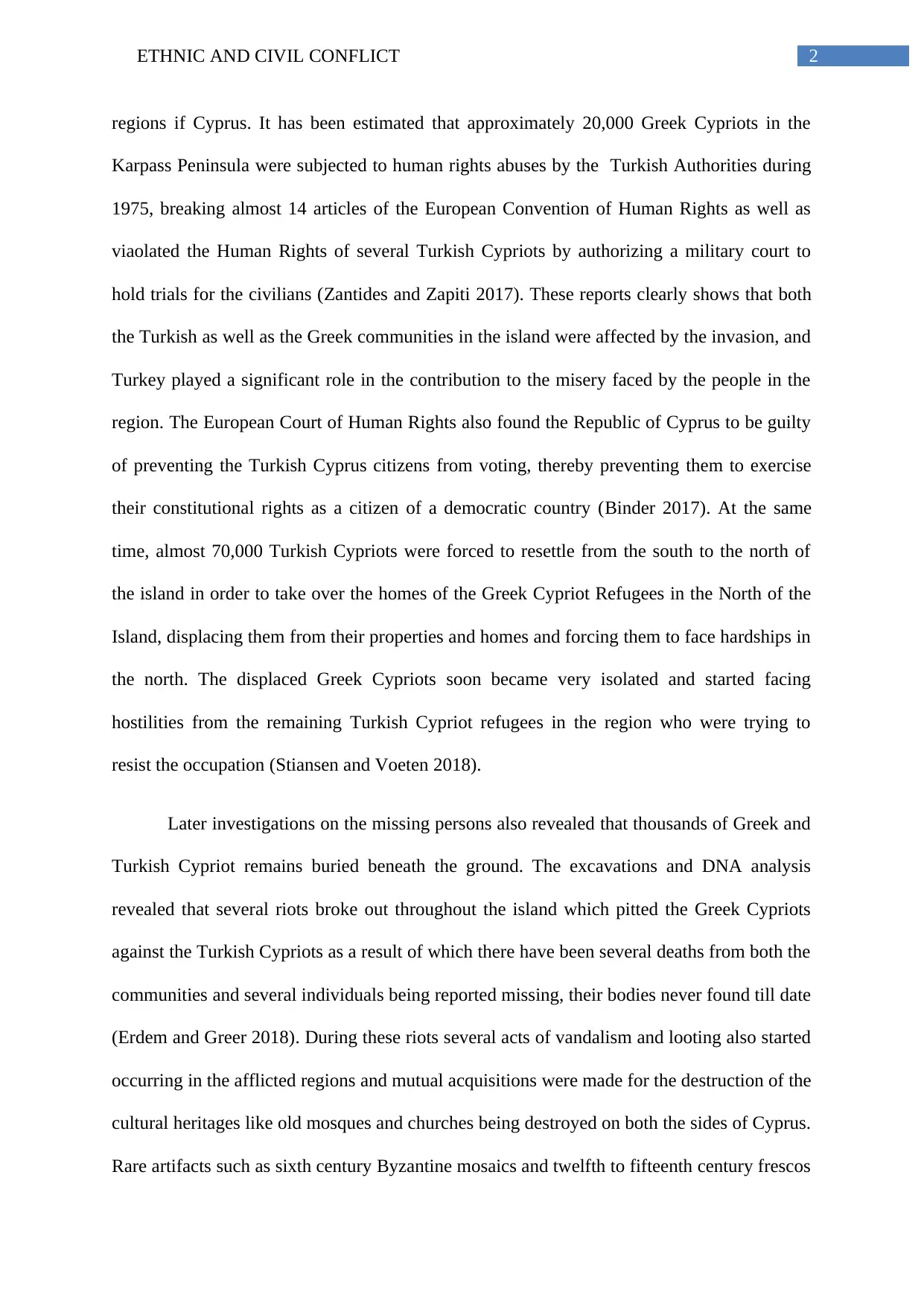
2ETHNIC AND CIVIL CONFLICT
regions if Cyprus. It has been estimated that approximately 20,000 Greek Cypriots in the
Karpass Peninsula were subjected to human rights abuses by the Turkish Authorities during
1975, breaking almost 14 articles of the European Convention of Human Rights as well as
viaolated the Human Rights of several Turkish Cypriots by authorizing a military court to
hold trials for the civilians (Zantides and Zapiti 2017). These reports clearly shows that both
the Turkish as well as the Greek communities in the island were affected by the invasion, and
Turkey played a significant role in the contribution to the misery faced by the people in the
region. The European Court of Human Rights also found the Republic of Cyprus to be guilty
of preventing the Turkish Cyprus citizens from voting, thereby preventing them to exercise
their constitutional rights as a citizen of a democratic country (Binder 2017). At the same
time, almost 70,000 Turkish Cypriots were forced to resettle from the south to the north of
the island in order to take over the homes of the Greek Cypriot Refugees in the North of the
Island, displacing them from their properties and homes and forcing them to face hardships in
the north. The displaced Greek Cypriots soon became very isolated and started facing
hostilities from the remaining Turkish Cypriot refugees in the region who were trying to
resist the occupation (Stiansen and Voeten 2018).
Later investigations on the missing persons also revealed that thousands of Greek and
Turkish Cypriot remains buried beneath the ground. The excavations and DNA analysis
revealed that several riots broke out throughout the island which pitted the Greek Cypriots
against the Turkish Cypriots as a result of which there have been several deaths from both the
communities and several individuals being reported missing, their bodies never found till date
(Erdem and Greer 2018). During these riots several acts of vandalism and looting also started
occurring in the afflicted regions and mutual acquisitions were made for the destruction of the
cultural heritages like old mosques and churches being destroyed on both the sides of Cyprus.
Rare artifacts such as sixth century Byzantine mosaics and twelfth to fifteenth century frescos
regions if Cyprus. It has been estimated that approximately 20,000 Greek Cypriots in the
Karpass Peninsula were subjected to human rights abuses by the Turkish Authorities during
1975, breaking almost 14 articles of the European Convention of Human Rights as well as
viaolated the Human Rights of several Turkish Cypriots by authorizing a military court to
hold trials for the civilians (Zantides and Zapiti 2017). These reports clearly shows that both
the Turkish as well as the Greek communities in the island were affected by the invasion, and
Turkey played a significant role in the contribution to the misery faced by the people in the
region. The European Court of Human Rights also found the Republic of Cyprus to be guilty
of preventing the Turkish Cyprus citizens from voting, thereby preventing them to exercise
their constitutional rights as a citizen of a democratic country (Binder 2017). At the same
time, almost 70,000 Turkish Cypriots were forced to resettle from the south to the north of
the island in order to take over the homes of the Greek Cypriot Refugees in the North of the
Island, displacing them from their properties and homes and forcing them to face hardships in
the north. The displaced Greek Cypriots soon became very isolated and started facing
hostilities from the remaining Turkish Cypriot refugees in the region who were trying to
resist the occupation (Stiansen and Voeten 2018).
Later investigations on the missing persons also revealed that thousands of Greek and
Turkish Cypriot remains buried beneath the ground. The excavations and DNA analysis
revealed that several riots broke out throughout the island which pitted the Greek Cypriots
against the Turkish Cypriots as a result of which there have been several deaths from both the
communities and several individuals being reported missing, their bodies never found till date
(Erdem and Greer 2018). During these riots several acts of vandalism and looting also started
occurring in the afflicted regions and mutual acquisitions were made for the destruction of the
cultural heritages like old mosques and churches being destroyed on both the sides of Cyprus.
Rare artifacts such as sixth century Byzantine mosaics and twelfth to fifteenth century frescos
⊘ This is a preview!⊘
Do you want full access?
Subscribe today to unlock all pages.

Trusted by 1+ million students worldwide
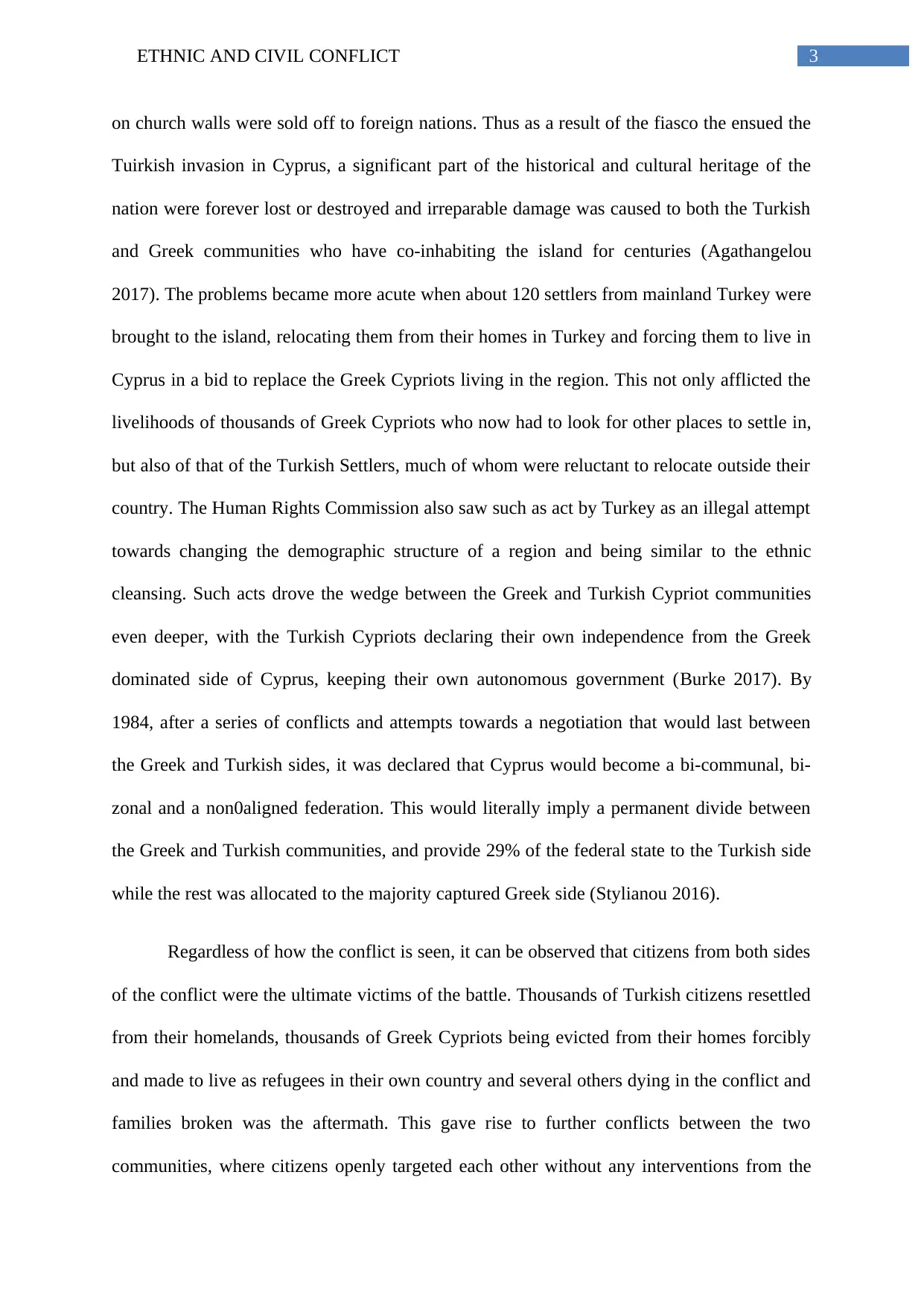
3ETHNIC AND CIVIL CONFLICT
on church walls were sold off to foreign nations. Thus as a result of the fiasco the ensued the
Tuirkish invasion in Cyprus, a significant part of the historical and cultural heritage of the
nation were forever lost or destroyed and irreparable damage was caused to both the Turkish
and Greek communities who have co-inhabiting the island for centuries (Agathangelou
2017). The problems became more acute when about 120 settlers from mainland Turkey were
brought to the island, relocating them from their homes in Turkey and forcing them to live in
Cyprus in a bid to replace the Greek Cypriots living in the region. This not only afflicted the
livelihoods of thousands of Greek Cypriots who now had to look for other places to settle in,
but also of that of the Turkish Settlers, much of whom were reluctant to relocate outside their
country. The Human Rights Commission also saw such as act by Turkey as an illegal attempt
towards changing the demographic structure of a region and being similar to the ethnic
cleansing. Such acts drove the wedge between the Greek and Turkish Cypriot communities
even deeper, with the Turkish Cypriots declaring their own independence from the Greek
dominated side of Cyprus, keeping their own autonomous government (Burke 2017). By
1984, after a series of conflicts and attempts towards a negotiation that would last between
the Greek and Turkish sides, it was declared that Cyprus would become a bi-communal, bi-
zonal and a non0aligned federation. This would literally imply a permanent divide between
the Greek and Turkish communities, and provide 29% of the federal state to the Turkish side
while the rest was allocated to the majority captured Greek side (Stylianou 2016).
Regardless of how the conflict is seen, it can be observed that citizens from both sides
of the conflict were the ultimate victims of the battle. Thousands of Turkish citizens resettled
from their homelands, thousands of Greek Cypriots being evicted from their homes forcibly
and made to live as refugees in their own country and several others dying in the conflict and
families broken was the aftermath. This gave rise to further conflicts between the two
communities, where citizens openly targeted each other without any interventions from the
on church walls were sold off to foreign nations. Thus as a result of the fiasco the ensued the
Tuirkish invasion in Cyprus, a significant part of the historical and cultural heritage of the
nation were forever lost or destroyed and irreparable damage was caused to both the Turkish
and Greek communities who have co-inhabiting the island for centuries (Agathangelou
2017). The problems became more acute when about 120 settlers from mainland Turkey were
brought to the island, relocating them from their homes in Turkey and forcing them to live in
Cyprus in a bid to replace the Greek Cypriots living in the region. This not only afflicted the
livelihoods of thousands of Greek Cypriots who now had to look for other places to settle in,
but also of that of the Turkish Settlers, much of whom were reluctant to relocate outside their
country. The Human Rights Commission also saw such as act by Turkey as an illegal attempt
towards changing the demographic structure of a region and being similar to the ethnic
cleansing. Such acts drove the wedge between the Greek and Turkish Cypriot communities
even deeper, with the Turkish Cypriots declaring their own independence from the Greek
dominated side of Cyprus, keeping their own autonomous government (Burke 2017). By
1984, after a series of conflicts and attempts towards a negotiation that would last between
the Greek and Turkish sides, it was declared that Cyprus would become a bi-communal, bi-
zonal and a non0aligned federation. This would literally imply a permanent divide between
the Greek and Turkish communities, and provide 29% of the federal state to the Turkish side
while the rest was allocated to the majority captured Greek side (Stylianou 2016).
Regardless of how the conflict is seen, it can be observed that citizens from both sides
of the conflict were the ultimate victims of the battle. Thousands of Turkish citizens resettled
from their homelands, thousands of Greek Cypriots being evicted from their homes forcibly
and made to live as refugees in their own country and several others dying in the conflict and
families broken was the aftermath. This gave rise to further conflicts between the two
communities, where citizens openly targeted each other without any interventions from the
Paraphrase This Document
Need a fresh take? Get an instant paraphrase of this document with our AI Paraphraser
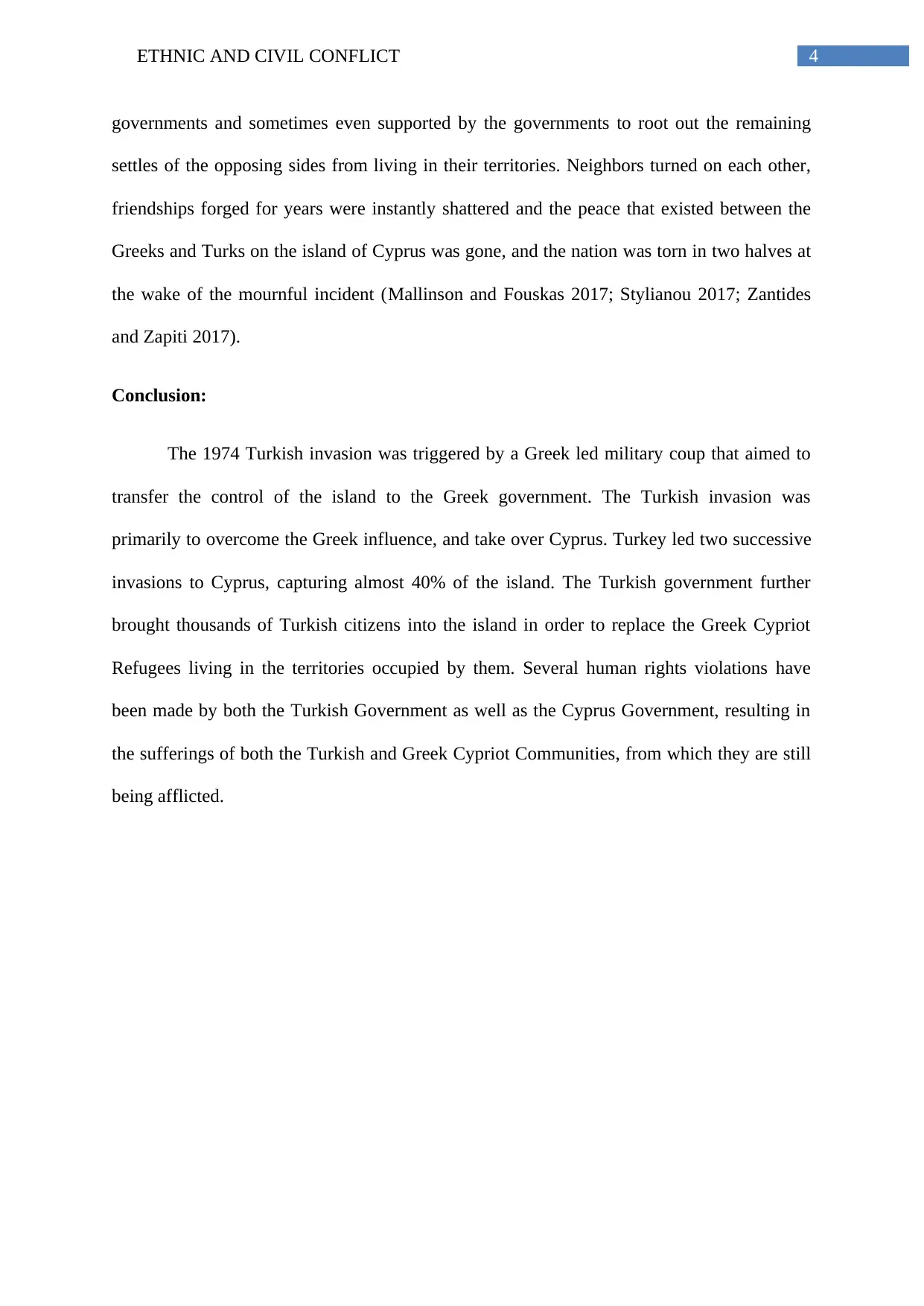
4ETHNIC AND CIVIL CONFLICT
governments and sometimes even supported by the governments to root out the remaining
settles of the opposing sides from living in their territories. Neighbors turned on each other,
friendships forged for years were instantly shattered and the peace that existed between the
Greeks and Turks on the island of Cyprus was gone, and the nation was torn in two halves at
the wake of the mournful incident (Mallinson and Fouskas 2017; Stylianou 2017; Zantides
and Zapiti 2017).
Conclusion:
The 1974 Turkish invasion was triggered by a Greek led military coup that aimed to
transfer the control of the island to the Greek government. The Turkish invasion was
primarily to overcome the Greek influence, and take over Cyprus. Turkey led two successive
invasions to Cyprus, capturing almost 40% of the island. The Turkish government further
brought thousands of Turkish citizens into the island in order to replace the Greek Cypriot
Refugees living in the territories occupied by them. Several human rights violations have
been made by both the Turkish Government as well as the Cyprus Government, resulting in
the sufferings of both the Turkish and Greek Cypriot Communities, from which they are still
being afflicted.
governments and sometimes even supported by the governments to root out the remaining
settles of the opposing sides from living in their territories. Neighbors turned on each other,
friendships forged for years were instantly shattered and the peace that existed between the
Greeks and Turks on the island of Cyprus was gone, and the nation was torn in two halves at
the wake of the mournful incident (Mallinson and Fouskas 2017; Stylianou 2017; Zantides
and Zapiti 2017).
Conclusion:
The 1974 Turkish invasion was triggered by a Greek led military coup that aimed to
transfer the control of the island to the Greek government. The Turkish invasion was
primarily to overcome the Greek influence, and take over Cyprus. Turkey led two successive
invasions to Cyprus, capturing almost 40% of the island. The Turkish government further
brought thousands of Turkish citizens into the island in order to replace the Greek Cypriot
Refugees living in the territories occupied by them. Several human rights violations have
been made by both the Turkish Government as well as the Cyprus Government, resulting in
the sufferings of both the Turkish and Greek Cypriot Communities, from which they are still
being afflicted.
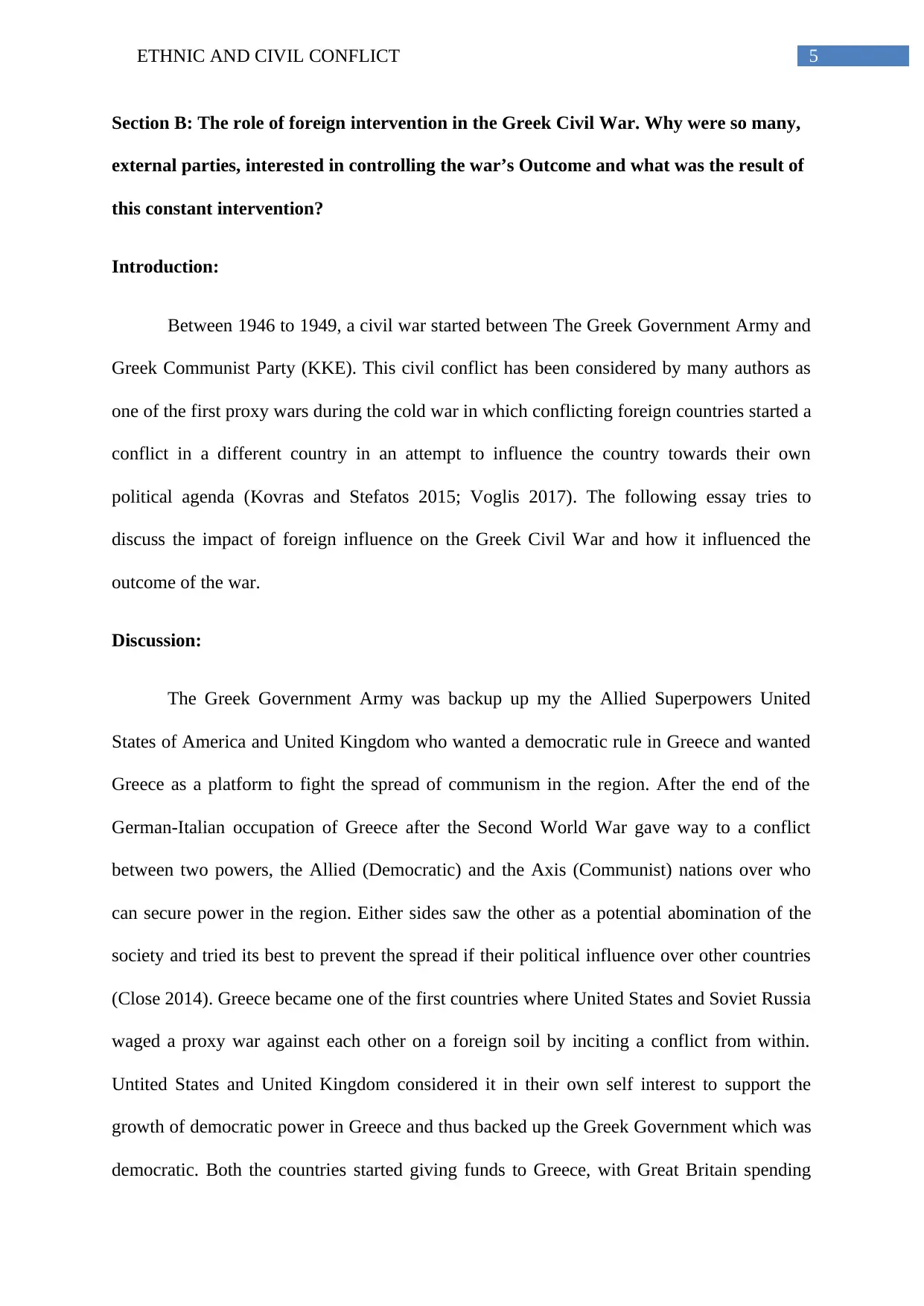
5ETHNIC AND CIVIL CONFLICT
Section B: The role of foreign intervention in the Greek Civil War. Why were so many,
external parties, interested in controlling the war’s Outcome and what was the result of
this constant intervention?
Introduction:
Between 1946 to 1949, a civil war started between The Greek Government Army and
Greek Communist Party (KKE). This civil conflict has been considered by many authors as
one of the first proxy wars during the cold war in which conflicting foreign countries started a
conflict in a different country in an attempt to influence the country towards their own
political agenda (Kovras and Stefatos 2015; Voglis 2017). The following essay tries to
discuss the impact of foreign influence on the Greek Civil War and how it influenced the
outcome of the war.
Discussion:
The Greek Government Army was backup up my the Allied Superpowers United
States of America and United Kingdom who wanted a democratic rule in Greece and wanted
Greece as a platform to fight the spread of communism in the region. After the end of the
German-Italian occupation of Greece after the Second World War gave way to a conflict
between two powers, the Allied (Democratic) and the Axis (Communist) nations over who
can secure power in the region. Either sides saw the other as a potential abomination of the
society and tried its best to prevent the spread if their political influence over other countries
(Close 2014). Greece became one of the first countries where United States and Soviet Russia
waged a proxy war against each other on a foreign soil by inciting a conflict from within.
Untited States and United Kingdom considered it in their own self interest to support the
growth of democratic power in Greece and thus backed up the Greek Government which was
democratic. Both the countries started giving funds to Greece, with Great Britain spending
Section B: The role of foreign intervention in the Greek Civil War. Why were so many,
external parties, interested in controlling the war’s Outcome and what was the result of
this constant intervention?
Introduction:
Between 1946 to 1949, a civil war started between The Greek Government Army and
Greek Communist Party (KKE). This civil conflict has been considered by many authors as
one of the first proxy wars during the cold war in which conflicting foreign countries started a
conflict in a different country in an attempt to influence the country towards their own
political agenda (Kovras and Stefatos 2015; Voglis 2017). The following essay tries to
discuss the impact of foreign influence on the Greek Civil War and how it influenced the
outcome of the war.
Discussion:
The Greek Government Army was backup up my the Allied Superpowers United
States of America and United Kingdom who wanted a democratic rule in Greece and wanted
Greece as a platform to fight the spread of communism in the region. After the end of the
German-Italian occupation of Greece after the Second World War gave way to a conflict
between two powers, the Allied (Democratic) and the Axis (Communist) nations over who
can secure power in the region. Either sides saw the other as a potential abomination of the
society and tried its best to prevent the spread if their political influence over other countries
(Close 2014). Greece became one of the first countries where United States and Soviet Russia
waged a proxy war against each other on a foreign soil by inciting a conflict from within.
Untited States and United Kingdom considered it in their own self interest to support the
growth of democratic power in Greece and thus backed up the Greek Government which was
democratic. Both the countries started giving funds to Greece, with Great Britain spending
⊘ This is a preview!⊘
Do you want full access?
Subscribe today to unlock all pages.

Trusted by 1+ million students worldwide
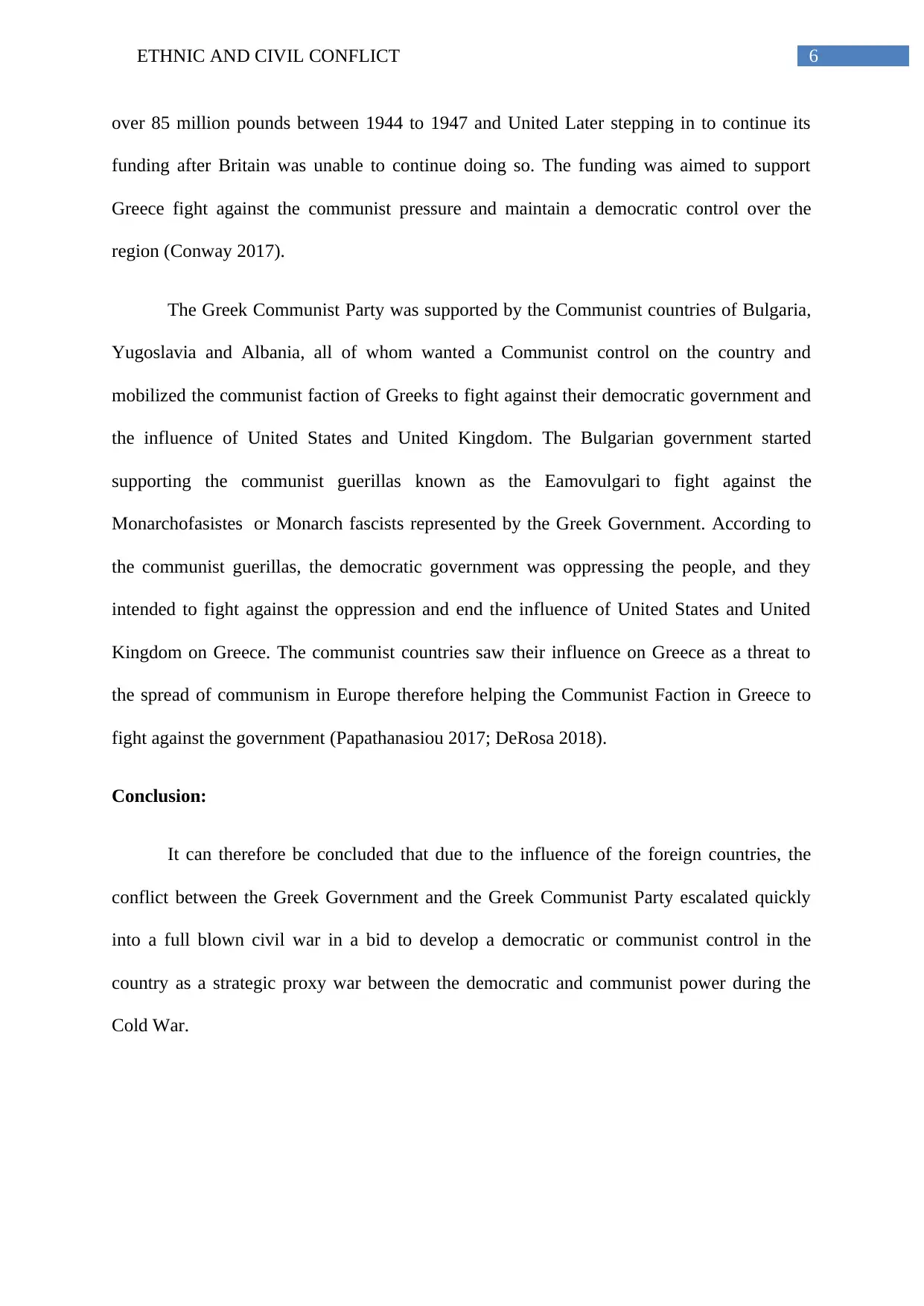
6ETHNIC AND CIVIL CONFLICT
over 85 million pounds between 1944 to 1947 and United Later stepping in to continue its
funding after Britain was unable to continue doing so. The funding was aimed to support
Greece fight against the communist pressure and maintain a democratic control over the
region (Conway 2017).
The Greek Communist Party was supported by the Communist countries of Bulgaria,
Yugoslavia and Albania, all of whom wanted a Communist control on the country and
mobilized the communist faction of Greeks to fight against their democratic government and
the influence of United States and United Kingdom. The Bulgarian government started
supporting the communist guerillas known as the Eamovulgari to fight against the
Monarchofasistes or Monarch fascists represented by the Greek Government. According to
the communist guerillas, the democratic government was oppressing the people, and they
intended to fight against the oppression and end the influence of United States and United
Kingdom on Greece. The communist countries saw their influence on Greece as a threat to
the spread of communism in Europe therefore helping the Communist Faction in Greece to
fight against the government (Papathanasiou 2017; DeRosa 2018).
Conclusion:
It can therefore be concluded that due to the influence of the foreign countries, the
conflict between the Greek Government and the Greek Communist Party escalated quickly
into a full blown civil war in a bid to develop a democratic or communist control in the
country as a strategic proxy war between the democratic and communist power during the
Cold War.
over 85 million pounds between 1944 to 1947 and United Later stepping in to continue its
funding after Britain was unable to continue doing so. The funding was aimed to support
Greece fight against the communist pressure and maintain a democratic control over the
region (Conway 2017).
The Greek Communist Party was supported by the Communist countries of Bulgaria,
Yugoslavia and Albania, all of whom wanted a Communist control on the country and
mobilized the communist faction of Greeks to fight against their democratic government and
the influence of United States and United Kingdom. The Bulgarian government started
supporting the communist guerillas known as the Eamovulgari to fight against the
Monarchofasistes or Monarch fascists represented by the Greek Government. According to
the communist guerillas, the democratic government was oppressing the people, and they
intended to fight against the oppression and end the influence of United States and United
Kingdom on Greece. The communist countries saw their influence on Greece as a threat to
the spread of communism in Europe therefore helping the Communist Faction in Greece to
fight against the government (Papathanasiou 2017; DeRosa 2018).
Conclusion:
It can therefore be concluded that due to the influence of the foreign countries, the
conflict between the Greek Government and the Greek Communist Party escalated quickly
into a full blown civil war in a bid to develop a democratic or communist control in the
country as a strategic proxy war between the democratic and communist power during the
Cold War.
Paraphrase This Document
Need a fresh take? Get an instant paraphrase of this document with our AI Paraphraser
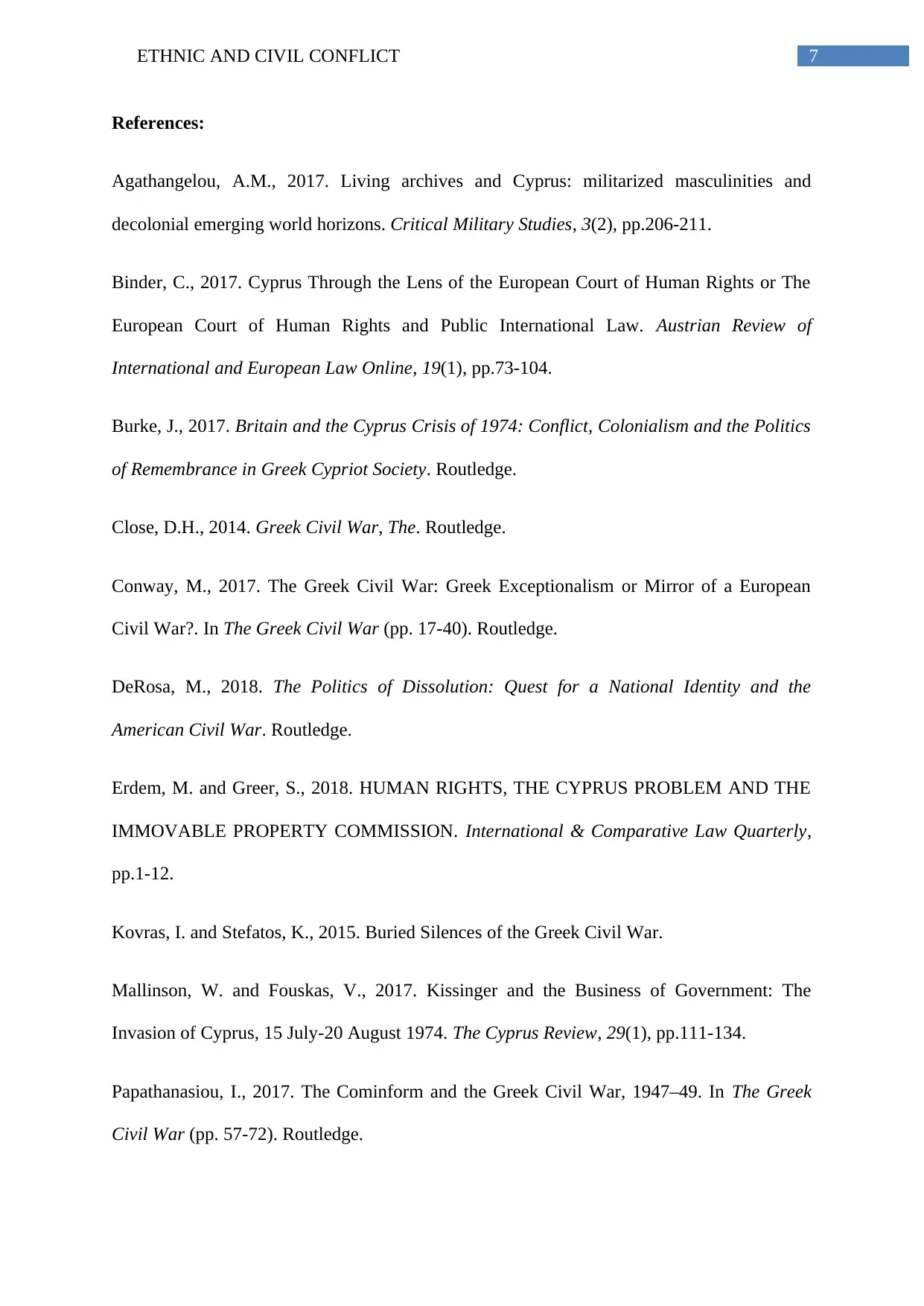
7ETHNIC AND CIVIL CONFLICT
References:
Agathangelou, A.M., 2017. Living archives and Cyprus: militarized masculinities and
decolonial emerging world horizons. Critical Military Studies, 3(2), pp.206-211.
Binder, C., 2017. Cyprus Through the Lens of the European Court of Human Rights or The
European Court of Human Rights and Public International Law. Austrian Review of
International and European Law Online, 19(1), pp.73-104.
Burke, J., 2017. Britain and the Cyprus Crisis of 1974: Conflict, Colonialism and the Politics
of Remembrance in Greek Cypriot Society. Routledge.
Close, D.H., 2014. Greek Civil War, The. Routledge.
Conway, M., 2017. The Greek Civil War: Greek Exceptionalism or Mirror of a European
Civil War?. In The Greek Civil War (pp. 17-40). Routledge.
DeRosa, M., 2018. The Politics of Dissolution: Quest for a National Identity and the
American Civil War. Routledge.
Erdem, M. and Greer, S., 2018. HUMAN RIGHTS, THE CYPRUS PROBLEM AND THE
IMMOVABLE PROPERTY COMMISSION. International & Comparative Law Quarterly,
pp.1-12.
Kovras, I. and Stefatos, K., 2015. Buried Silences of the Greek Civil War.
Mallinson, W. and Fouskas, V., 2017. Kissinger and the Business of Government: The
Invasion of Cyprus, 15 July-20 August 1974. The Cyprus Review, 29(1), pp.111-134.
Papathanasiou, I., 2017. The Cominform and the Greek Civil War, 1947–49. In The Greek
Civil War (pp. 57-72). Routledge.
References:
Agathangelou, A.M., 2017. Living archives and Cyprus: militarized masculinities and
decolonial emerging world horizons. Critical Military Studies, 3(2), pp.206-211.
Binder, C., 2017. Cyprus Through the Lens of the European Court of Human Rights or The
European Court of Human Rights and Public International Law. Austrian Review of
International and European Law Online, 19(1), pp.73-104.
Burke, J., 2017. Britain and the Cyprus Crisis of 1974: Conflict, Colonialism and the Politics
of Remembrance in Greek Cypriot Society. Routledge.
Close, D.H., 2014. Greek Civil War, The. Routledge.
Conway, M., 2017. The Greek Civil War: Greek Exceptionalism or Mirror of a European
Civil War?. In The Greek Civil War (pp. 17-40). Routledge.
DeRosa, M., 2018. The Politics of Dissolution: Quest for a National Identity and the
American Civil War. Routledge.
Erdem, M. and Greer, S., 2018. HUMAN RIGHTS, THE CYPRUS PROBLEM AND THE
IMMOVABLE PROPERTY COMMISSION. International & Comparative Law Quarterly,
pp.1-12.
Kovras, I. and Stefatos, K., 2015. Buried Silences of the Greek Civil War.
Mallinson, W. and Fouskas, V., 2017. Kissinger and the Business of Government: The
Invasion of Cyprus, 15 July-20 August 1974. The Cyprus Review, 29(1), pp.111-134.
Papathanasiou, I., 2017. The Cominform and the Greek Civil War, 1947–49. In The Greek
Civil War (pp. 57-72). Routledge.
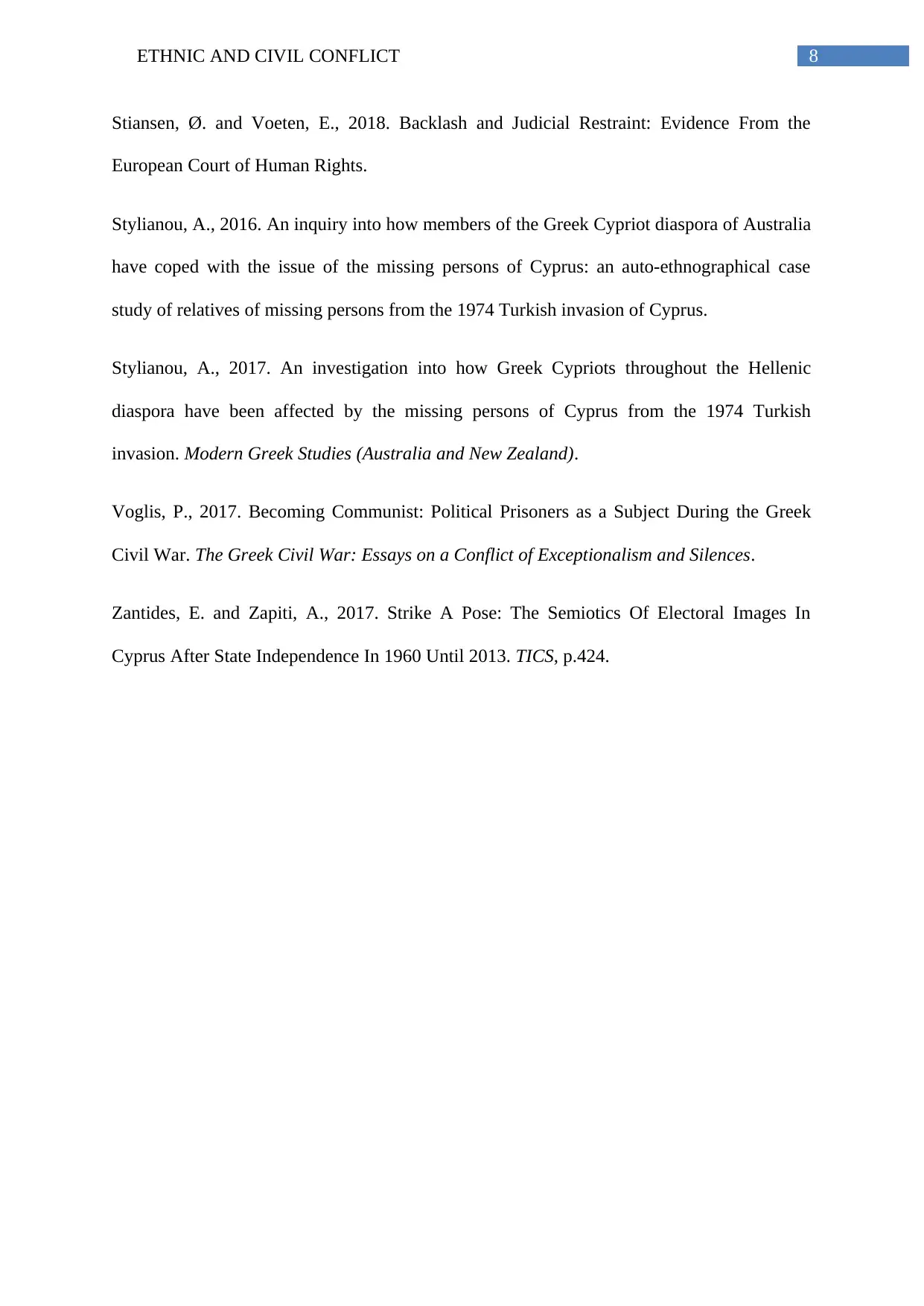
8ETHNIC AND CIVIL CONFLICT
Stiansen, Ø. and Voeten, E., 2018. Backlash and Judicial Restraint: Evidence From the
European Court of Human Rights.
Stylianou, A., 2016. An inquiry into how members of the Greek Cypriot diaspora of Australia
have coped with the issue of the missing persons of Cyprus: an auto-ethnographical case
study of relatives of missing persons from the 1974 Turkish invasion of Cyprus.
Stylianou, A., 2017. An investigation into how Greek Cypriots throughout the Hellenic
diaspora have been affected by the missing persons of Cyprus from the 1974 Turkish
invasion. Modern Greek Studies (Australia and New Zealand).
Voglis, P., 2017. Becoming Communist: Political Prisoners as a Subject During the Greek
Civil War. The Greek Civil War: Essays on a Conflict of Exceptionalism and Silences.
Zantides, E. and Zapiti, A., 2017. Strike A Pose: The Semiotics Of Electoral Images In
Cyprus After State Independence In 1960 Until 2013. TICS, p.424.
Stiansen, Ø. and Voeten, E., 2018. Backlash and Judicial Restraint: Evidence From the
European Court of Human Rights.
Stylianou, A., 2016. An inquiry into how members of the Greek Cypriot diaspora of Australia
have coped with the issue of the missing persons of Cyprus: an auto-ethnographical case
study of relatives of missing persons from the 1974 Turkish invasion of Cyprus.
Stylianou, A., 2017. An investigation into how Greek Cypriots throughout the Hellenic
diaspora have been affected by the missing persons of Cyprus from the 1974 Turkish
invasion. Modern Greek Studies (Australia and New Zealand).
Voglis, P., 2017. Becoming Communist: Political Prisoners as a Subject During the Greek
Civil War. The Greek Civil War: Essays on a Conflict of Exceptionalism and Silences.
Zantides, E. and Zapiti, A., 2017. Strike A Pose: The Semiotics Of Electoral Images In
Cyprus After State Independence In 1960 Until 2013. TICS, p.424.
⊘ This is a preview!⊘
Do you want full access?
Subscribe today to unlock all pages.

Trusted by 1+ million students worldwide

9ETHNIC AND CIVIL CONFLICT
1 out of 10
Your All-in-One AI-Powered Toolkit for Academic Success.
+13062052269
info@desklib.com
Available 24*7 on WhatsApp / Email
![[object Object]](/_next/static/media/star-bottom.7253800d.svg)
Unlock your academic potential
Copyright © 2020–2025 A2Z Services. All Rights Reserved. Developed and managed by ZUCOL.